Land, Water & Biodiversity
Work Package lead: Imperial College London
UPDATE: The expert consultation workshop on “The future of land use, water and biodiversity in Europe” took place in London on the 19-20 September 2018 – for an overview of the workshop and outputs see http://www.european-calculator.eu/2018/09/26/the-future-of-land-use-water-and-biodiversity-in-europe-overview-of-the-expert-consultation-workshop/
Module design
Calculation Flow & Input/ Output Matrix
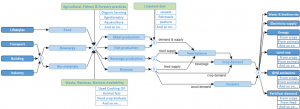
The module design is described in a tree-like calculation flow and a matrix specifying interactions with other sectors or modules.
Data & Assumptions
Overview and ambition level definition

Overview of the data collected, gathered and presented.
Implementation
Timeline, KNIME flow and progress documentation

A timeline and a flow visualization of the programmed module have been created to show progress and compare implementation to the module design
Your feedback and comments are much appreciated, questions will be addressed rapidly.
Module design
The Land, Water & Biodiversity module (WP4) aims at modelling and evaluating the potential land’s exploitation pathways, with respect to end-user’s choices. The scope of WP4 includes a broad range of sectors, namely, the agriculture, fishery and forestry modules; the biomass, bio-sourced materials, and bioenergy modules; the mineral module; and the land-use module. Alongside these modules, WP4 also track the extent of how the different pathways may affect water and biodiversity across WPs.
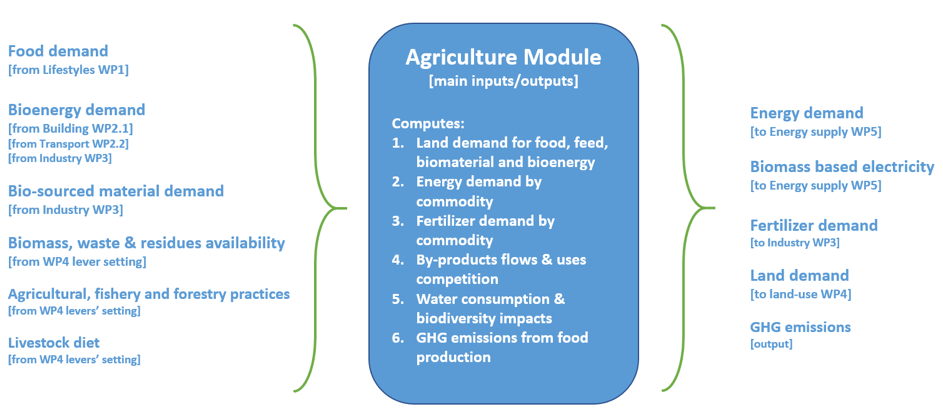
The main drivers for Agriculture (WP4) are the dietary choices from Lifestyle WP1, including the demand for nearly 30 food groups; bioenergy & bio-sourced materials (liquid, solid, gas biomass) from Building, Transport (WP2) and Industry (WP3); the biomass, waste and residues availability enables modelling the availability but also competition between the possible uses. The agricultural, fishery and forest practices enables us considering the extent of multiple impacts (such as water use, fertilizer use, land-use, biodiversity, and so on). The livestock diet put the emphasis on possible pathway to feed the livestock, such as algae and insect-based meals. The main outputs consist of the land, energy, water, fertilizer requirement, as well as GHG emissions and biomass-based electricity supply. The following Figure illustrates the calculation tree of the WP4 Agriculture module.
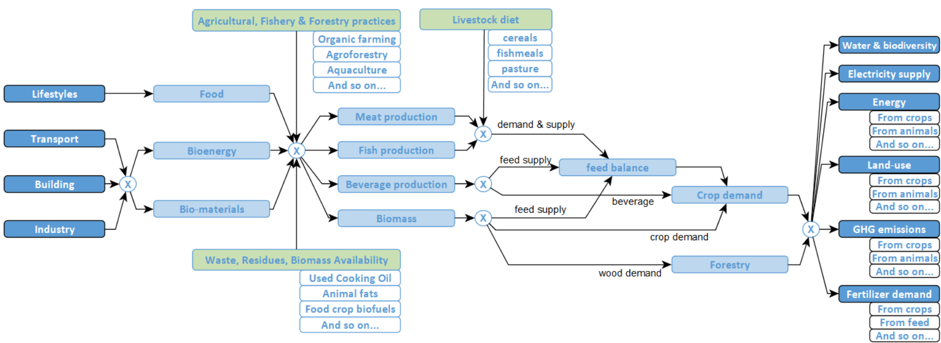
The main drivers for Land-Use (WP4) are the Agriculture, Minerals and Energy supply modules (WP4&5) balanced against desired levels of conservation of biodiversity (e.g., meeting Aichi 2020 biodiversity targets). The land availability and covers are also driven by the land-management lever which sets, for example, the land surplus allocation when good practices enable freeing lands. As an output, the module provides the land allocation and the associated GHG emissions (sources and sinks). It is worth mentioning that land use allocation is following a hierarchy in which food supply is always met.
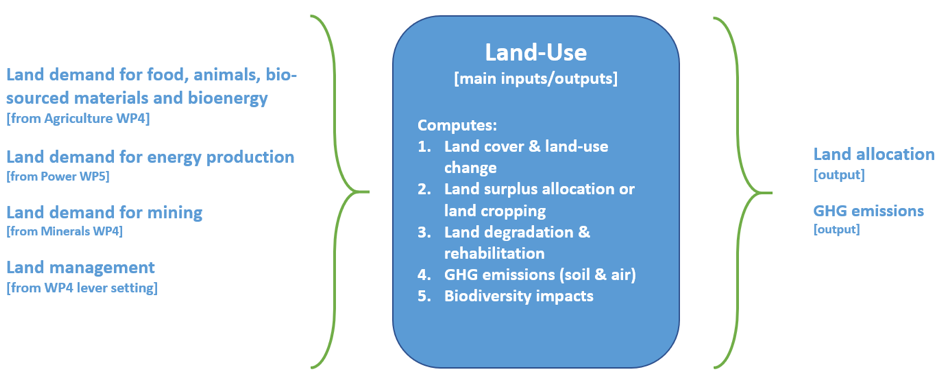
Data & Assumptions
In WP4, end-users will be able to define the levels of ambition through 8 levers, including (1) agricultural practices (including agroforestry, organic farming, urban agriculture, and so on), that will drive the production pathways for commodities and their associated impacts; (2) Fishery practices (e.g. intensive, extensive aquaculture, organic fishery farming, and so on) that will drive the production pathways for commodities; (3) Forestry practices (e.g. sustainable management, harvesting intensity and so on) that will drive the forest management; (4) Livestock diets (e.g. cereals, grains, animal meals, and so on), which will drive the production pathways for animal commodities; (5) Waste and residues will set the amount of un- and collected wastes, which also will interact with the biomass availability lever (6); the later will drive biomass towards different uses; (7) land management (e.g. land rehabilitation, degradation, and do on) which will enable us computing the land availability; (8) biodiversity conservation targets. The last lever (9) is associated with the mining practices which will affect the mineral production impacts.
The definitive set of levers, as well as the calibration of the ambition levels will be refined and formalised through a co-creation workshop with stakeholders, scheduled in London for September 2018, 19th and 20th. Calibration will also require a careful attention regarding the data availability and granularity. WP4 is currently being built based on EUROSTAT (food, energy), FAO-STAT (food), FishStatJ (fishery), INRA-CIRAD-AFZ (feed).
Implementation
The following Figure represents the status regarding the implementation stage of each WP4 sub-modules.
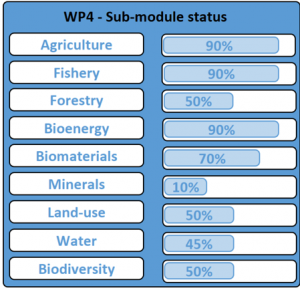
Agriculture and Fishery modules mainly computes the feed, energy, fertilizer, water and land-use demand based on the end-user’s practices choices. Biodiversity remains to be tracked, by linking it to the land use allocation, and also through agricultural and fishery practices (bycatches, eco-system impacts and so on). By-products yielded are also modelled and are driven towards multiple sectors, such as bioenergy, biochemicals and son on. Biomaterial and bioenergy modules are also at an advanced stage of modelling but remain to be calibrated. It is worth mentioning that calibration will require the stakeholders’ outputs by September 2018.
Land-use, water and biodiversity modelling is at an intermediate stage. Land-use concerning the above-mentioned modules is already modelled but biodiversity and water impacts remain to be implemented. Minerals module is non-CORE and it is still at an early stage of implementation. It will be developed consistently regarding the agriculture, fishery and forestry practices. Mining practices will be defined and implemented so the end-users may choose different pathway to produce minerals through more sustainable ways.

The next step for WP4 will be to complete the calibration of the CORE model for the expert engagement workshop by September 2018.
Contact point
Contact for questions about the data and module
- Gino Baudry, g.baudry@imperial.ac.uk
- Onesmus Mwabonje, o.mwabonje@imperial.ac.uk
- Jeremy Woods, jeremy.woods@imperial.ac.uk
